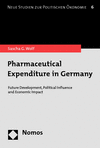Abstract
Der Arzneimittelsektor der Gesetzlichen Krankenversicherung stand wiederholt im Fokus zahlreicher Gesundheitsreformen. Dennoch ist es bislang nicht gelungen, den Trend steigender Ausgaben nachhaltig zu bremsen. Die vorliegende Untersuchung leistet einen Beitrag dazu, die Ursachen dieser Entwicklung zu erklären und Lösungsansätze aufzuzeigen. Mittels Hauptkomponenten- und Cluster-Analyse wurden Gruppen von Arzneimitteln mit vergleichbaren Konsumeigenschaften gebildet. Jede Gruppe wurde auf den Einfluss der Altersabhängigkeit und des technologischen Fortschritts hin analysiert. Aufbauend auf diesen Ergebnissen wurde eine Prognose der zukünftigen Ausgabenentwicklung bis zum Jahr 2050 erstellt. Obwohl die Hauptkostenfaktoren exogen sind, steht der Gesetzgeber dem vorhergesagten ansteigenden Kostenpfad nicht hilflos gegenüber. Im Gegenteil: Anhand ökonometrischer Tests wird gezeigt, dass die Gesundheitspolitik in der Vergangenheit durch wahl- und klientelorientierte Interessendurchsetzung geprägt war. Mehr Effizienz in der Arzneimittelversorgung könnte durch die Einführung individueller Gesundheitssparkonten erzielt werden. Dies bestätigen die Resultate eines vertikal differenzierten Wettbewerbsmodells.
Zusammenfassung
Der Arzneimittelsektor der Gesetzlichen Krankenversicherung stand wiederholt im Fokus zahlreicher Gesundheitsreformen. Dennoch ist es bislang nicht gelungen, den Trend steigender Ausgaben nachhaltig zu bremsen. Die vorliegende Untersuchung leistet einen Beitrag dazu, die Ursachen dieser Entwicklung zu erklären und Lösungsansätze aufzuzeigen. Mittels Hauptkomponenten- und Cluster-Analyse wurden Gruppen von Arzneimitteln mit vergleichbaren Konsumeigenschaften gebildet. Jede Gruppe wurde auf den Einfluss der Altersabhängigkeit und des technologischen Fortschritts hin analysiert. Aufbauend auf diesen Ergebnissen wurde eine Prognose der zukünftigen Ausgabenentwicklung bis zum Jahr 2050 erstellt. Obwohl die Hauptkostenfaktoren exogen sind, steht der Gesetzgeber dem vorhergesagten ansteigenden Kostenpfad nicht hilflos gegenüber. Im Gegenteil: Anhand ökonometrischer Tests wird gezeigt, dass die Gesundheitspolitik in der Vergangenheit durch wahl- und klientelorientierte Interessendurchsetzung geprägt war. Mehr Effizienz in der Arzneimittelversorgung könnte durch die Einführung individueller Gesundheitssparkonten erzielt werden. Dies bestätigen die Resultate eines vertikal differenzierten Wettbewerbsmodells.
- 11–12 Contents 11–12
- 15–16 1. Introduction 15–16
- 17–18 2.1. Introduction 17–18
- 25–26 2.4.1. Data 25–26
- 34–37 2.4.4. Results 34–37
- 37–38 2.5.1. Data 37–38
- 38–39 2.5.2. Methodology 38–39
- 39–42 2.5.3. Results 39–42
- 44–44 2.7. Conclusion 44–44
- 45–46 3.1. Introduction 45–46
- 59–60 3.5.4. Results 59–60
- 66–66 3.7. Conclusion 66–66
- 67–68 4.1. Introduction 67–68
- 82–84 4.6.1. Coinsurance 82–84
- 89–89 4.8. Conclusion 89–89
- 90–92 5. Conclusion 90–92
- 93–98 Appendix 93–98
- 99–108 Bibliography 99–108

